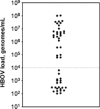Human bocavirus and acute wheezing in children
- PMID: 17342639
- PMCID: PMC7107819
- DOI: 10.1086/512196
Human bocavirus and acute wheezing in children
Abstract
Background: Human bocavirus is a newly discovered parvovirus. It has been detected primarily in children with acute lower respiratory tract infection, but its occurrence, clinical profile, and role as a causative agent of respiratory tract disease are not clear.
Methods: We investigated the presence of human bocavirus by quantitative polymerase chain reaction of nasopharyngeal aspirate specimens and selected serum samples obtained from 259 children (median age, 1.6 years) who had been hospitalized for acute expiratory wheezing. The samples were analyzed for 16 respiratory viruses by polymerase chain reaction, virus culture, antigen detection, and serological assays.
Results: At least 1 potential etiologic agent was detected in 95% of children, and >1 agent was detected in 34% of children. Human bocavirus was detected in 49 children (19%). A large proportion of the cases were mixed infections with other viruses, but human bocavirus was the only virus detected in 12 children (5%). High viral loads of human bocavirus were noted mainly in the absence of other viral agents, suggesting a causative role for acute wheezing. In addition, infections that had uncertain clinical relevance and low viral loads were prevalent. Human bocavirus DNA was frequently detected in serum specimens obtained from patients with acute wheezing, suggesting systemic infection.
Conclusions: Human bocavirus is prevalent among children with acute wheezing and can cause systemic infection. Results suggest a model for bocavirus infection in which high viral loads are potentially associated with respiratory symptoms and low viral loads indicate asymptomatic shedding. Therefore, quantitative polymerase chain reaction analysis may be important for additional studies of human bocavirus.
Figures





Comment in
-
Human bocavirus: a new viral pathogen.Clin Infect Dis. 2007 Apr 1;44(7):911-2. doi: 10.1086/512438. Epub 2007 Feb 14. Clin Infect Dis. 2007. PMID: 17342640 Free PMC article. No abstract available.
-
Human bocavirus in children with acute asthma.Clin Infect Dis. 2007 Aug 1;45(3):404-5. doi: 10.1086/519505. Clin Infect Dis. 2007. PMID: 17599330 No abstract available.
References
-
- Lopez AD, Mathers CD, Ezzati M, Jamison DT, Murray CJ. Global and regional burden of disease and risk factors, 2001: systematic analysis of population health data. Lancet. 2006;367:1747–57. - PubMed
-
- Shay DK, Holman RC, Newman RD, Liu LL, Stout JW, Anderson LJ. Bronchiolitis-associated hospitalizations among US children, 1980–1996. JAMA. 1999;282:1440–6. - PubMed
Publication types
MeSH terms
Substances
LinkOut - more resources
Full Text Sources
Other Literature Sources

